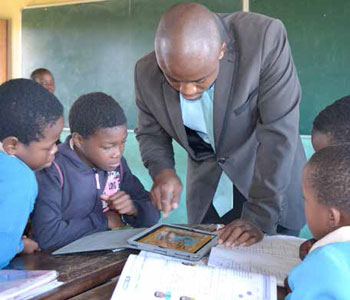For years 11-year-old Awande Mhlongo and his classmates drew circles and ticks on their books trying to answer mathematics problems. When they ran out of pages, they would use their fingers to get to the answer.
 Today Mhlongo, along with some of his classmates at Gobamahlamvu Primary School in Umlalazi, KwaZulu- Natal, is one of the top mathematics pupils in his class thanks to the iSchoolAfrica Rural Development Programme.
Today Mhlongo, along with some of his classmates at Gobamahlamvu Primary School in Umlalazi, KwaZulu- Natal, is one of the top mathematics pupils in his class thanks to the iSchoolAfrica Rural Development Programme.
The project takes technology to some of the most under resourced rural schools in the country.
n 2009, the Department of Rural Development and Land Reform (DRDLR) started taking information and communication technologies (ICTs) to rural communities in the form of ICT centres that provide access to government services, learning and training material, employment opportunities and communication.
DRDLR works with iSchoolAfrica, a private company, to develop and roll out the iSchool Africa Rural Development Programme. It has supported at least 77 rural schools nationally with 40 iPads per school.
One of those schools is Mhlongo’s. He wants to be a doctor and his classmates regard him as a “genius”. They sit quietly around him as he uses the iPad to do his calculations.
“Awande helps me with maths using the iPad. The iPads have helped us because we do not use our hands to count anymore,” says 11-year-old Sfundo Zwane, who wants to be a policeman.
Sbonelo Makhoba, 11, adds that they also use the iPads to take pictures and videos.
iSchoolAfrica and its partners - the DRDLR and the Council for Scientific and Industrial Research (CSIR) - visited schools in KZN that have benefited from the project.
iSchoolAfrica Project Director, Michelle Lissoos, describes the project as the “beginning of a model that works”.
“We often meet in offices with our partners but the critical part is engaging with schools themselves. We make it a priority to get feedback….. the project is changing learning in rural areas,” she says.
Lissoos is impressed as mathematics teacher Lungisa Khanyile uses an iPad to project sums onto the wall instead of writing on the board. He says the attention Grade 4 learners give their studies has improved since they started using iPads.
Khanyile says another advantage is that when there is a shortage of books, teachers scan the book and project it on the wall using the iPad so all learners can follow.
Principal of Gobamahlamvu Primary School Thobi Thwala says the iPads have helped boost literacy and numeracy in her schools.
“We were waiting for computers but we got the iPads which are more interactive. The learners enjoy using them,” she says.
About three kilometres from Gobamahlamvu, at Samungu Primary School, Esmeralda Reid from the DRDLS’s Information and Communications Technology Directorate is captivated by Muzi Zondi’s teaching methods. Zondi, who teaches English, asks his pupils to name and then describe emotions. While one pupil demonstrates the emotion, his classmates capture a picture of it on the iPad. The demonstrations spark outbursts of laughter among the officials and classroom.
Zondi says that using iPads increases the focus of learners and he makes sure that they are used in line with the teaching curriculum.
The iPads have sparked 10-year-old Lindokuhle Mthembu’s interest in mathematics.
“I also like reading from the iPad,” the aspiring doctor.
Reid interacted with the pupils and witnessed first-hand how the project is shaping unfortuthe lives and education of the pupils.
“The schools are happy and they are able to do things digitally now,” she says.
CSIR Operations Manager Hennie Bezuidenhout is equally impressed and delighted with the project. ‘I am here to be part of the project.
I can sit at the office but it is good to be here (in the schools)…. It is good to see the learners’ joy when they work on the iPads and view the information,” he said.



 Facebook
Facebook Twitter
Twitter WhatsApp
WhatsApp